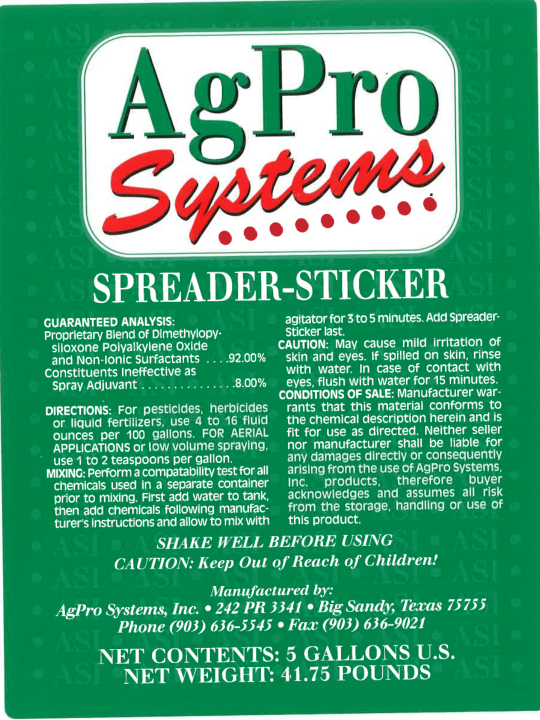
![]()
Overview
Our SPREADER STICKER with its proprietary enzyme base helps make plants more receptive to pesticides.
SPREADER STICKER is a general purpose surfactant for ground applied herbicides, fungicides and fertilizers. Its surfactants help it stick to the leaves and its wetting agents penetrate the soil taking the chemical to the roots.
Due to its superior qualities as a sticker, many growers have reduced the number of sprayings required during a season for pest control, saving chemical and application dollars.
General Information
AgPro™ SPREADER STICKER is a unique and superior non-ionic surfactant and sticker, effective in pesticide application. It ensures complete coverage.
Growers and golf courses also use it as a soil penetrant because of its soil stimulant qualities.
| Guaranteed Analysis | |
| Proprietary Blend of Polydimethylsiloxane Poly-alkylene Oxide and non-ionic surfactants Constituents ineffective as spray adjuvant |
92.00% 8.00% |
Directions for Use
AgPro™ SPREADER STICKER is recommended for use with non-selective herbicides and other pesticides including those used to desiccate or defoliate. Some pesticides may require higher or lower spreader-sticker rates for the desired results. Follow the pesticide label directions. When used as a penetrant SPREADER STICKER can be mixed with most fertilizers and pesticides.
Application Information
The following applications are recommended for:
- Aerial: As a Spreader Sticker: Apply 1 to 2 fl. oz. per 1 gallon of spray.
- Ground: As a Spreader Sticker: 4 to 10 fl. oz. per 100 gallons of spray.
- Agricultural Field Crops: As a Soil Penetrant: Apply 16 to 64 fl. oz. per acre.
- Golf Courses: As a Soil Penetrant: Apply 32 to 64 fl. oz. per acre.
- Lawns and Turf: As a Soil Penetrant: Apply 32 to 64 fl. oz. per acre.
Mixing
- Prior to application, all spray/mixing and application equipment must be cleaned. Carefully observe all cleaning directions on product label.
- To prevent or minimize foaming, fill tank 3/4 full of water.
- Add pesticides and/or fertilizers as directed by label or in following order.
A. Fertilizer and micronutrients
B. Dry flowables and dispersible granules
C. Flowables
D. Water soluble pesticides
E. Emulsifiable concentrates - Continue agitation
- Add Spreader Sticker and mix with normal agitation.
- Continue filling tank maintaining agitation.
- For optimum results spray mixtures containing Spreader Sticker should be applied within 36 hours
Storage and Disposal
Store in original container only. Keep container tightly closed. Do not allow water to be introduced into contents of container. Do not contaminate water sources by runoff from cleaning of equipment, disposal of equipment wash water or spray waste. Do not store near heat or open flame. Container Disposal: Triple rinse (or equivalent) container. Offer for recycling or puncture and dispose of according to state and local authorities. If burned, stay out of smoke.
What to Do in Case of Contact
- IF SWALLOWED: Give a large amount of water to drink. DO NOT induce vomiting or give anything by mouth to an unconscious person.
- IF IN EYES: Immediately flush with clean water for 15 minutes. Consult a physician if symptoms persist.
- IF ON SKIN: Remove contaminated clothing and wash with soap and water. If contact is made with the spray solution containing pesticides, follow the “Statement of Practical Treatment” on the pesticide label. Consult a physician if irritation persists.
Caution
Avoid contact with skin, eyes, or clothing. Do not apply in such a manner as to directly or through drift expose workers or other people. If mixed with pesticides follow precautionary statements on the accompanying pesticide label.
KEEP OUT OF REACH OF CHILDREN
SHAKE WELL BEFORE EACH USE
KEEP FROM FREEZING
Notice
Disclaimer: The information contained herein is furnished without warranty of any kind. Users should consider this data only as a supplement to other information gathered by them and must make independent determinations of suitability and completeness of information from all sources to assure proper use and disposal of these materials and the safety and health of employees and customers and the protection of the environment.